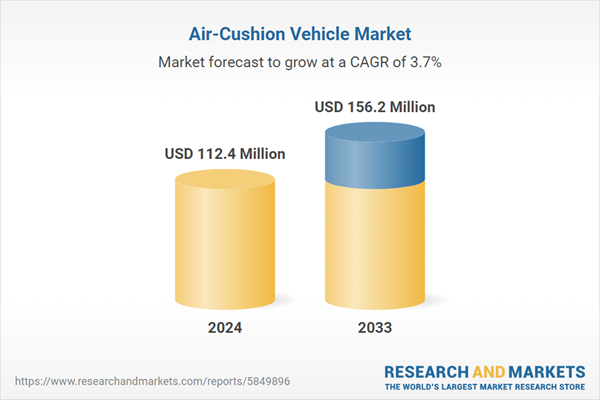An air-cushion vehicle (ACV), commonly known as a hovercraft, is a type of transportation that relies on a cushion of air to glide over various surfaces, including land, water, ice, and marshy terrains. In contrast to conventional vehicles, which need wheels or tracks to move, an ACV uses the concepts of buoyancy and propulsion to float and move ahead. The air cushion, which is produced by a strong fan, or several fans placed underneath the car, is the essential part of an ACV. By pushing air into a plenum chamber, these fans create a high-pressure area. As the pressure increases, it eventually overcomes the craft's weight and lifts it off the ground or water. Once the ACV is airborne, it hovers on a thin cushion of air, which reduces the friction and allows it to move with relative ease. The air cushion not only provides lift but also acts as a lubricant, enabling the vehicle to traverse over different terrains smoothly. Steering and directional control are achieved by using rudders or thrust vectoring mechanisms. Some hovercraft designs incorporate multiple fans and skirts around the periphery to optimize lift and control. They have the capacity to move across nearly any flat surface, regardless of its state or obstructions, which is one of their main advantages.
Air-Cushion Vehicle Market Trends:
The escalating demand for accessibility and versatility among the masses majorly drives the global market. ACVs are capable of operating on diverse surfaces, including water, mud, ice, and even open fields. This versatility allows ACVs to reach areas where traditional vehicles cannot venture, providing access to remote locations, disaster-stricken areas, and environments with limited infrastructure. Therefore, the widespread adoption of air-cushion vehicles (ACV) to transport goods and individuals in challenging conditions for industries such as search and rescue, oil and gas exploration, tourism, and military operations is impacting the market. Along with this, the growing popularity of ACVs due to their advantages, such as high speeds over various terrains, surpassing conventional vehicles, and even some watercraft is significantly supporting the market. In addition, the ability of ACVs to traverse sensitive ecosystems without causing significant disruption or pollution is also catalyzing their demand led by the growing environmental consciousness. Apart from this, the rising deployment of ACVs in offshore industries such as oil and gas exploration, offshore wind farms, and marine research to enable the transportation of personnel and equipment to offshore installations is contributing to the market. Furthermore, the development of more efficient and environmentally friendly propulsion systems, improved materials, and enhanced control systems is creating a positive market outlook. Some of the other factors driving the market include rapid urbanization and significant growth in the automotive sector.Key Market Segmentation:
The publisher provides an analysis of the key trends in each segment of the global air-cushion vehicle (ACV) market, along with forecasts at the global, regional, and country levels from 2025-2033. Our report has categorized the market based on type and application.Type Insights:
- Amphibious Air-cushion Vehicles
- Sidewall Air-cushion Vehicles
Application Insights:
- Military
- Commercial
Regional Insights:
- North America
- United States
- Canada
- Asia Pacific
- China
- Japan
- India
- South Korea
- Australia
- Indonesia
- Others
- Europe
- Germany
- France
- United Kingdom
- Italy
- Spain
- Russia
- Others
- Latin America
- Brazil
- Mexico
- Others
- Middle East and Africa
Competitive Landscape:
The report has also provided a comprehensive analysis of the competitive landscape in the global air-cushion vehicle (ACV) market. The detailed profiles of all major companies have been provided. Some of the companies covered include Aerohod Ltd., Airlift Hovercraft Pty Ltd, Garden Reach Shipbuilders & Engineers Ltd., Griffon Hoverwork Ltd. (The Bland Group Ltd.), Hovertechnics LLC, Neoteric Hovercraft Inc., The British Hovercraft Company, Vanair Hovercraft, etc. Kindly note that this only represents a partial list of companies, and the complete list has been provided in the report.Key Questions Answered in This Report:
How has the global air-cushion vehicle (ACV) market performed so far, and how will it perform in the coming years?What are the drivers, restraints, and opportunities in the global air-cushion vehicle (ACV) market?
What is the impact of each driver, restraint, and opportunity on the global air-cushion vehicle (ACV) market?
What are the key regional markets?
Which countries represent the most attractive air-cushion vehicle (ACV) market?
What is the breakup of the market based on the type?
Which is the most attractive type in the air-cushion vehicle (ACV) market?
What is the breakup of the market based on the application?
Which is the most attractive application in the air-cushion vehicle (ACV) market?
What is the competitive structure of the global air-cushion vehicle (ACV) market?
Who are the key players/companies in the global air-cushion vehicle (ACV) market?
Table of Contents
Companies Mentioned
- Aerohod Ltd.
- Airlift Hovercraft Pty Ltd
- Garden Reach Shipbuilders & Engineers Ltd.
- Griffon Hoverwork Ltd. (The Bland Group Ltd.)
- Hovertechnics LLC
- Neoteric Hovercraft Inc.
- The British Hovercraft Company
- Vanair Hovercraft
Table Information
| Report Attribute | Details |
|---|---|
| No. of Pages | 130 |
| Published | January 2025 |
| Forecast Period | 2024 - 2033 |
| Estimated Market Value ( USD | $ 112.4 Million |
| Forecasted Market Value ( USD | $ 156.2 Million |
| Compound Annual Growth Rate | 3.7% |
| Regions Covered | Global |
| No. of Companies Mentioned | 8 |









